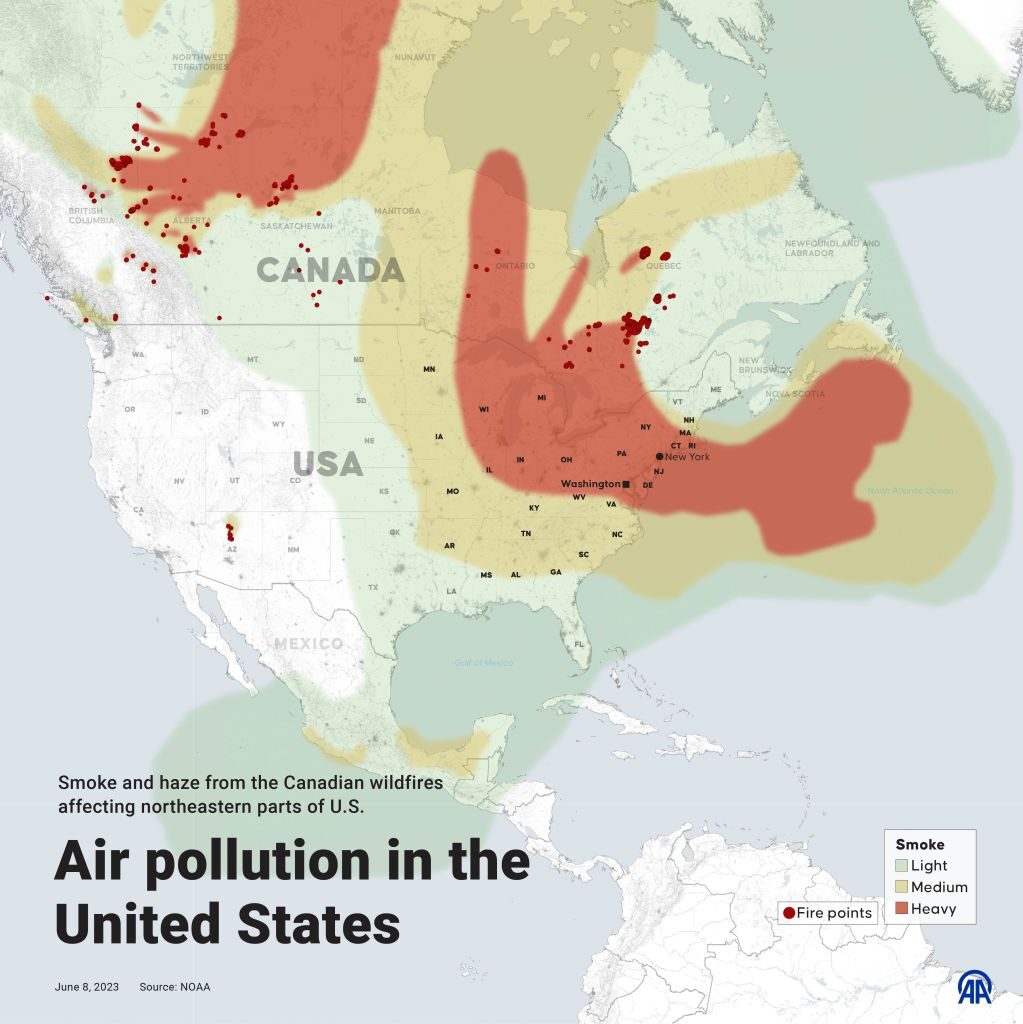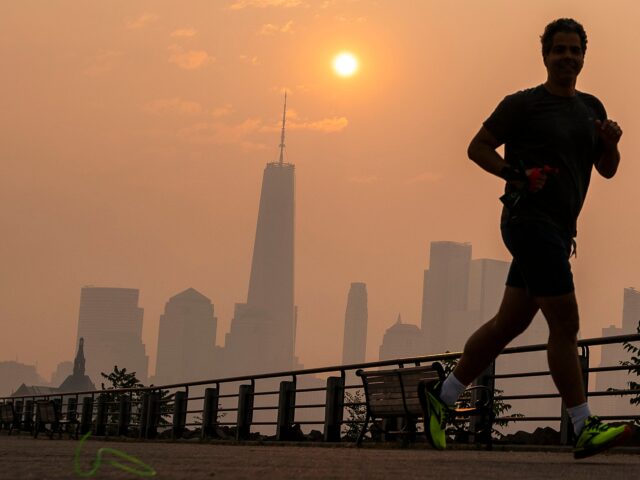The mayor of Montreal, Valérie Plante, told reporters on Wednesday her city had offered the provincial government of Quebec firefighters to help control the over 100 wildfires spreading in the region and engulfing the American Northeast and Midwest in smoke – but Quebec refused them.
The remark is particularly shocking as the premier, or top provincial executive official, of Quebec claimed this week that the province only had enough firefighters to address 30 wildfires, emphasizing, “we need all the help possible.” Quebec is reportedly receiving firefighters and supplies from America and France, while the Canadian government is in talks with countries as far away as Costa Rica and Chile for more help.
“We’re seeing more and more of these fires because of climate change. These fires are affecting everyday routines, lives and livelihoods, and our air quality,” Trudeau said in a post on Twitter on Wednesday.
We’re seeing more and more of these fires because of climate change. These fires are affecting everyday routines, lives and livelihoods, and our air quality. We’ll keep working – here at home and with partners around the world – to tackle climate change and address its impacts.
— Justin Trudeau (@JustinTrudeau) June 7, 2023
As of Wednesday evening, Canadian forest fire officials documented 362 active wildfires nationwide, 140 of them in Quebec, an unprecedented crisis. Government experts have blamed most of the fires on lightning strikes hitting extremely dry forest areas and a lack of rain in the eastern half of the country. Radical leftist Canadian Prime Minister Justin Trudeau claimed “climate change” caused the fires this week.
The fires have shrouded much of the American Northeast and Midwest in dangerous orange smoke, forcing millions to remain indoors as much as possible and prompting health alerts in some of the country’s largest cities. New York City documented the worst quality air of any city on the planet on Wednesday, particularly dangerous for children, the elderly, and those with respiratory conditions. New Jersey registered its worst air quality in nearly half a century. Echoing the early days of the Wuhan coronavirus pandemic, local officials urged residents to stay indoors and, if leaving the house, wear N-95 masks.
In Quebec, the government has evacuated multiple communities near the fires, leaving thousands displaced. The air quality has not dropped to the hazardous levels seen in much of America or the rest of Canada at press time, however, though a change in the direction of the wild could rapidly worsen conditions.
The Montreal Gazette reported on Wednesday that Quebec, after asking for as much aid in combatting its fires as possible, apparently rejected help from its largest city.
“We’re closer (than France) and we can lend a hand, but we were told by the province that for the moment, what they have is sufficient,” Plante, the mayor of Montreal, said on Wednesday. “I think you have to ask (Public Security Minister François) Bonnardel (why).”
Plante noted that Montreal has the largest fire department in Quebec and free firefighters to deploy.
Like many other Canadian politicians, Plante has blamed the fires on general “climate disturbances.”
“On this World Environment Day, nature is crying out for help,” Plante wrote on her Twitter account on Monday. “Climate disturbances are more and more frequent and their consequences are more serious. It is more important than ever to accelerate the ecological transition.”
🌬️ Avertissements de smog dans la région métropolitaine
🌡️ Records de chaleur battus dans le sud du Québec
🔥 Feux de forêt dans plusieurs régions et qui forcent l’évacuation de la population de Sept-Îles
En cette Journée mondiale de l’environnement, la nature crie à l’aide.…
— Valérie Plante (@Val_Plante) June 5, 2023
“Ecological transition” or “green transition” is a term used by climate alarmists to refer to humanity as a whole abandoning the use of “fossil fuels” – the abundant oil, natural gas, and other resources traditionally used for development. In their stead, climate alarmists support a variety of unproven alternatives, including electric vehicles powered by rare-earth mineral use, wind, and solar energy. Some support nuclear energy.
The Gazette reported that, according to provincial officials, American and French firefighters are flying in to aid the efforts. The official forest fire agency of the Quebecois government, SOPFEU, reportedly has all staff working on quelling the fires. SOPFEU told the Montreal Gazette through a spokesperson that it “has all the firefighters it can handle for the moment” because it needs to process and train non-Quebecois firefighters before they can deploy.
“She explained that SOPFEU prefers to recruit firefighters whose principal vocation is fighting wildfires, as they have different qualifications and training from firefighters trained for blazes within structures,” the newspaper noted.
The premier of Quebec, François Legault, told reporters on Tuesday that his government was in talks with America, France, Costa Rica, Portugal, and Chile for more firefighters and technological resources to contain the fires. As of Thursday, the CBC reported that American and French firefighters were slated to arrive in Quebec on Thursday, as well as firefighters from New Brunswick province and water bomber planes from Nova Scotia. The CBC did not mention any reinforcements from Montreal.
The administration of President Joe Biden has so far promised over 600 American firefighters and more water bombers. As of Wednesday, CTV News reported that almost 1,000 international firefighters were expected in Canada generally.
A lack of firefighters and lack of new and ready-to-use water bombers have both arisen as a significant problem for the Canadian government as the country’s hazardous smoke becomes an international problem.
“On Wednesday, Andrés Fontecilla, the Québec solidaire critic for public security, introduced a motion in the National Assembly expressing concerns that SOPFEU only had the resources to fight 30 fires,” the Montreal Gazette reported, “and requesting that the government, “in the framework of its efforts to adapt to climate change, increase SOPFEU’s ability to intervene.”
According to the newspaper, Canada is considering establishing a federal emergency agency, akin to America’s FEMA, to address both fires and other natural disasters. In the face of its lack of staffing, SOPFEU has insisted that it was prepared for an average year of wildfires, but its plans were thwarted by the unprecedented scale of the emergency.
“Never before did we have a situation where all the provinces had needs at the same time,” spokesperson Karine Pelletier said. “Normally the fire period varies from east to west. But this year it’s very different.”
The Canadian Press noted that, in addition to insufficient manpower, Canada does not appear prepared to manufacture and maintain as many water bombers – aircraft that can dump water onto large wildfires – as it needs for its dry seasons. It is already flying Montana water bombers in Quebec in an attempt to contain the fires there.

An infographic created on June 8, 2023 shows smoke and haze from the Canadian wildfires affecting northeastern parts of U.S. (Photo by Yasin Demirci/Anadolu Agency via Getty Images)
“In Canada, we have 55 Canadair planes — a combination of CL-215s and CL-415s … considering the number of fires currently in the country, it’s absolutely insufficient,” John Gradek, the coordinator of McGill University’s aviation management program, told the Canadian Press, noting that some of the planes were half a century old and Canada no longer domestically manufactures them.
One company, Viking Air, is slated to return manufacturing of water bombers to Canada, but will not begin producing the aircraft until 2027 and has already reserved two dozen planes for global buyers.
Legault acknowledged the lack of functional water bombers this week: “When we see a CL-215 that we can’t use because of maintenance issues, you have to ask yourself, do we need more mechanics? The answer is probably yes. Do we need to buy some additional new planes? I think that’s more the way we have to look at it.”
Follow Frances Martel on Facebook and Twitter.

COMMENTS
Please let us know if you're having issues with commenting.